Note: This website was automatically translated, so some terms or nuances may not be completely accurate.
How should we mobilize customers, employees, and business operations to build a strong organization?
On July 16, Dentsu Inc., Dentsu Digital Inc., and BeBit jointly hosted a webinar titled "What Transformation is Required in the Era of the New Normal?"
In the era of living with COVID-19, the term "new normal" is often heard, referring to accepting irreversible changes and creating a new society and new norms. But what exactly is the new normal, and what isn't?
Three experts with diverse perspectives discussed what companies should focus on in the era of living with COVID-19, without getting bogged down in the definition of the term.
In the final session, Mr. Katsumasa Yagi, Head of the DX Division at Dentsu Digital Inc., proposes the organizational structure companies should aim for during the pandemic.
<Table of Contents>
▼Start Small and Transform Big with Five Keys
▼The New Era's "Four-Way Win" Seen in Southern All Stars
▼How to Drive "Customers," "Employees," and "Business" for DX Acceleration?
▼Three Transformation Directions Japanese Companies Should Pursue
(Moderator: Takuya Kagata, Dentsu Digital Inc. )
  ;   ;  ;  ;   ;   ;   ;
Five Keys to Starting Small and Achieving Big Transformation
With the broad direction companies should pursue now clear, Katsumasa Yagi of Dentsu Digital Inc. took the stage as the final speaker.
He established the Transformation Consulting & Design organization at the company and serves as an Executive Officer in the DX domain, making him arguably the person most knowledgeable about how Japanese companies must execute DX right now.
The keyword he presented for transformation was:
"Start Small with Five Keys, Transform Big"
.
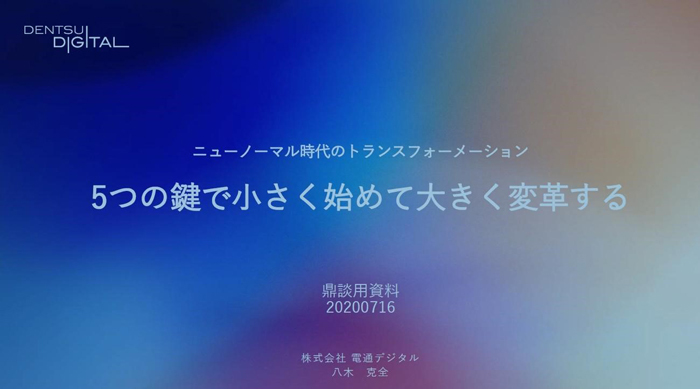
Mr. Yagi began by introducing the book "Seven Capitalisms," which he said he learned about from Mr. Toshihiko Aizawa, formerly of am/pm.
This book reveals how "capitalism," despite appearing to be a very simple concept, is applied completely differently by each country. It explains that no matter how brilliant a concept may be, it cannot function unless it aligns with a country's culture and values.
The book states, "Japanese capitalism is one where cooperation and competition coexist—essentially, a contradiction between collectivism and individualism." Mr. Yagi remarked, "It made perfect sense," adding, "There was much to learn from it regarding the current COVID-19 situation."
Here, Mr. Yagi proposed, "There are five keys to advancing what Mr. Suzuki calls 'Four-Way Goodness'."
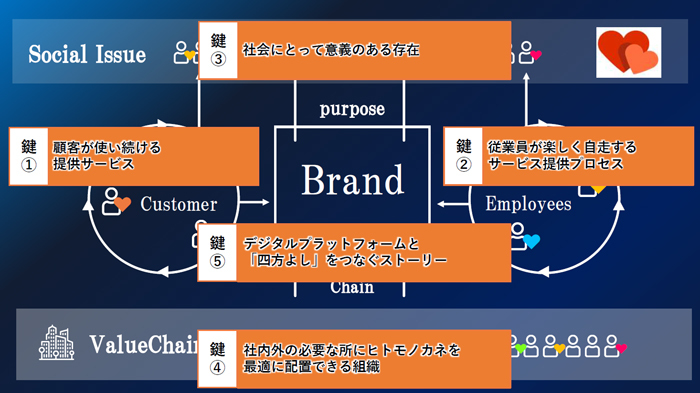
- Key 1: Services Customers Keep Using
- Key 2: Service delivery processes that employees enjoy and drive autonomously
- Key 3: A meaningful presence for society
- Key 4: A narrative connecting the digital platform and 'Four-Way Good'
- Key 5: An organization that optimally allocates people, resources, and capital where needed, both internally and externally
Each of these keys starts small and ultimately grows into the brand itself—this is transformation in the new normal era.
The New Era of "Four-Way Benefit" Seen in Southern All Stars
As a concrete example, Mr. Yagi first cited the Southern All Stars special live concert mentioned earlier by Mr. Fujii.
Yokohama Arena holds a maximum of 17,000 people. At ¥9,500 per ticket, that would generate ¥160 million in revenue. However, by digitally streaming this concert for a fee, Southern All Stars reportedly reached 500,000 simultaneous viewers, potentially generating around ¥648 million in revenue.
"It really shows that digital platforms are working for sellers right now. For example, 'catch-up streaming' capitalizes on buzz generated on social media, or Spotify immediately releasing a playlist recreating the day's setlist. I see this less as a one-off event and more as a case where the experience has evolved into truly enjoying music – and enjoying it at a fundamentally high quality."
Mr. Yagi then addressed the subsequent "keys" to success.
"Due to COVID, many staff lost their jobs. They deployed 400 live staff to create and stream high-quality content as usual. News articles covering this emerged, and fans who saw them felt even more compelled to support Southern All Stars. They also wanted to support the behind-the-scenes staff making these events happen. This message resonated socially and went viral."
Here, Mr. Yagi organized Southern All Stars' case into the initial "five keys":
- Key 1: When customers used the service, they received a high-quality real-time experience, and complementary online measures like catch-up streaming and playlist distribution worked well.
- Key 2: It provided a place for live event staff, who had lost their venues due to COVID-19, to contribute.
- Key 3: The fundamental value proposition was always the experience of seeing something live in a large, physical venue. But beyond that, customers developed a motivation: "I want to pay and contribute to pandemic countermeasures." Furthermore, the fact that all these circumstances, including media coverage, were shared relatively favorably within society carries significant meaning.
- Key 4: The value chain functioned effectively. Amuse, which had already invested in high-quality paid livestreams without an audience, was the foundation. Digital streaming platforms then built upon this. Solidly filling this value chain was crucial this time.
- Key 5: With these keys 1-4 in place, it was embraced as a major Japanese event and functioned well as full-scale entertainment while preventing the spread of infection.
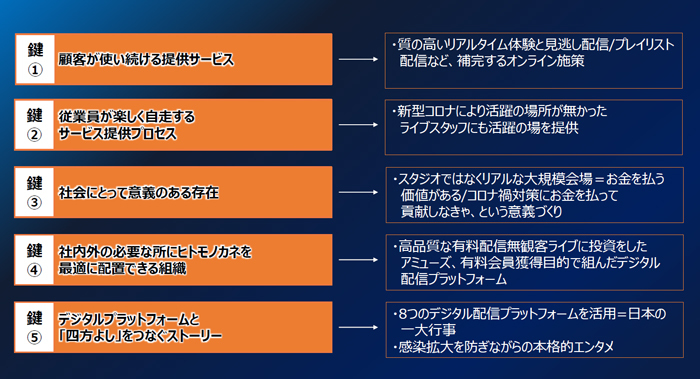
Through such examples, Yagi states that Suzuki's proposed "Four-Way Win" approach can be realized. He also reiterated that developing strategies while considering the first four keys in particular tends to yield better results.
How to Drive "Customers," "Employees," and "Business" for DX Acceleration?
Thus, even without direct human contact points, there is a sense that "digital high-touch" will accelerate. For Yagi,
"Accelerating corporate DX will make society happier faster. It's an area worth tackling,"
He revealed a sense of mission.
To leverage these efforts in regular business operations, he identified "three things to move": "customers," "employees," and "business."
"The key insight may lie in moving customers and employees to drive the business," Yagi suggested.
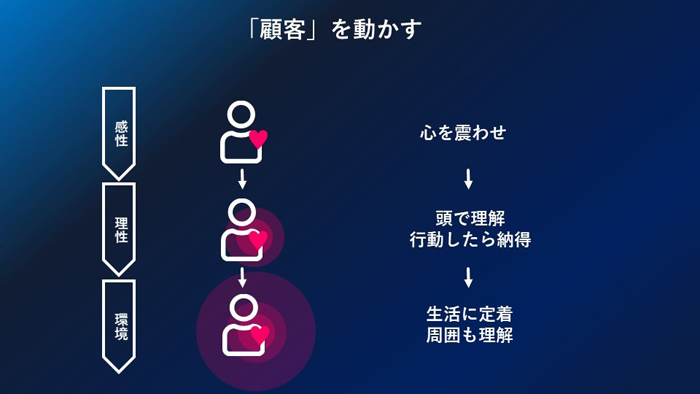

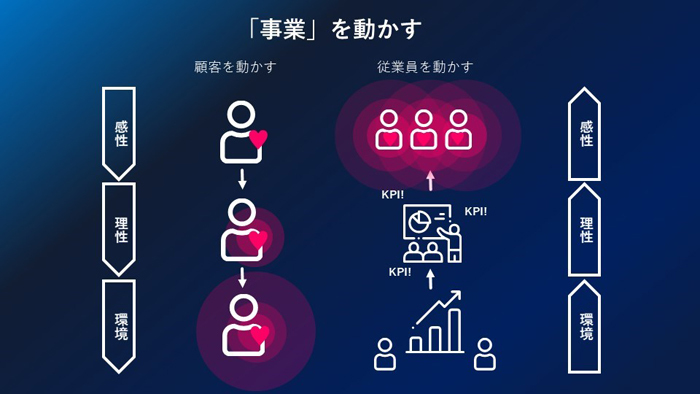
Regarding moving customers first, he explained that it requires touching their hearts, gaining their intellectual understanding, and finally convincing them through physical action. "That's precisely what leads to it becoming part of their lives, gaining the understanding of those around them, and ultimately leading to continued purchases and usage."
Moving employees, on the other hand, involves the company establishing its mission and organizational structure, preparing the environment, placing employees within that framework, setting KPIs, and driving the business forward within those parameters. When the business is successful, employees feel a sense of conviction and pride, leading them to act autonomously. Only after achieving this can we truly say we've "moved the employees," Yagi stated.
In other words, to move customers, the sequence is "emotion," "reason," and "environment." To move employees, it's the reverse. Those driving the business must think with the premise that "this is the sequence in which things move."
Therefore, when conceptualizing and planning a business, it's necessary to first move the customer's heart and prepare the employee's environment. However, this alone won't suffice. To actually create a good situation, you must aim for a state where both customers and employees are convinced, feel motivated, and act autonomously. Creating this state is the most difficult part, Yagi stated.
Employees present a particular challenge. While customers follow a customer journey, with a flow starting at the top of the funnel where interest is sparked and continues through usage, employees exist in separate silos—from product development to alliances. Different people end up facing the same customer, making it difficult to consider "customers and employees" as a set.
So how can this be done successfully? Mr. Yagi introduced two successful examples.
"One is an insurance company. When a car owner thinks, 'Tomorrow is supposed to be a once-in-five-years heavy snowfall. What if something happens to my car?' What does the company do? They send a message: 'Do you plan to drive tomorrow?' 'In the unlikely event of damage from snow or hail, your vehicle insurance coverage applies.' By properly analyzing policyholder customer data, they can proactively send out the necessary information via chat, email, or call center at the right time. Data proves this approach contributes to the business."
Another example is a life insurance company.
"During sales meetings, representatives listen intently to the customer's situation. But if something happens and they call the call center, they have to explain everything from scratch again. This often leads to customers canceling their policies. If the initial sales information were entered into the database and linked, the appropriate representative could handle the call. Also, for example, if a customer has children, having an operator with children of a similar age handle the call makes it easier to talk since they're both moms, and this also reduces cancellation rates."
Furthermore, he introduced an example from an overseas fashion brand that uses influencers—essentially employees who embody both the customer's and the employee's perspective, like pro-customers—to influence customers through social media and other channels.
Now, after engaging customers and employees, we move to the "driving the business" phase. Mr. Yagi introduced Meituan Dianping, China's third-largest platform operator after Alibaba and Tencent.
"This company operates primarily as a food delivery and review service, akin to Uber Eats combined with Tabelog. They first acquire users through frequently used food services, then successfully connect that user community to adjacent, less frequently used services—such as sending customers to hotels or restaurants and securing reservations. They've proven their platform strength, and their profits have skyrocketed."
Citing this example, Mr. Yagi stated his resolve: "In China, companies are emerging one after another that successfully leverage data exchanged between customers and employees to expand into new businesses. We must reinterpret this for Japan and consider how to implement it."
Three Directions for Transformation Japanese Companies Should Aim For
Summarizing the webinar, Mr. Yagi proposed three transformative directions for Japanese companies.
"First, rather than separating customers and employees, we should help corporate activities by having them collaborate together. Create many communities where people can engage in candid exchanges – some as pro-customers advising the brand, others as pro-employees communicating the brand's strengths – and open these to society. Through this, companies and brands can offer society the Japanese concept of 'cooperation and competition'."

"Second, use the data accumulated in these communities as a basis for judgment to determine how to extend your company's service value chain. Build a robust value chain, utilizing forms like business partnerships. Data provides hints for such decision-making."
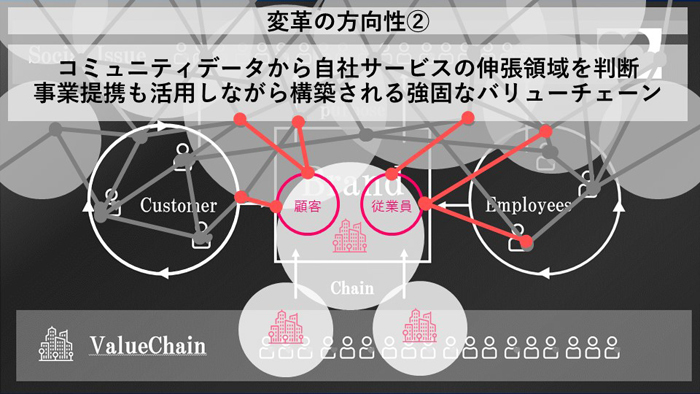
"Finally, the third point: many companies are now trying to connect their customers and employees to the value chain in this way. When doing so, it's crucial to clearly identify their 'unique raison d'être' and advance it while listening to the voices of both customers and employees. I believe these three directions will enable us to build strong organizations that function effectively within society."
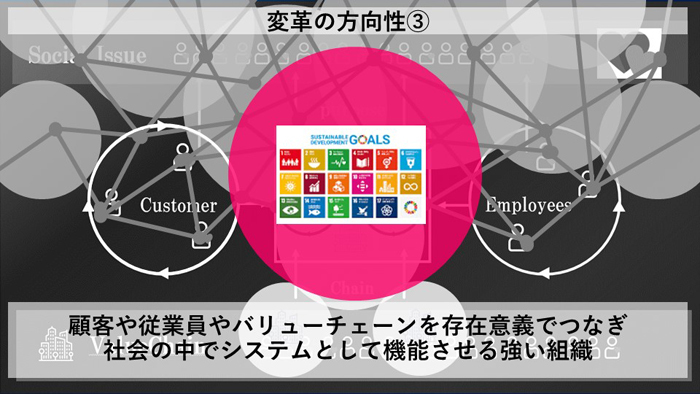
Was this article helpful?
Newsletter registration is here
We select and publish important news every day
For inquiries about this article
Back Numbers
Author

Katsumasa Yagi
Dentsu Consulting Inc.
President and CEO / Senior Partner
After joining Dentsu Inc., he worked in the Sales Division and marketing consulting organization, involved in new business development and service development. From 2016, he participated in the launch of Dentsu Digital Inc. As an Executive Officer, he led the Transformation Consulting organization and was responsible for numerous growth domain projects structured from both design and business perspectives. He has held his current position since January 2022. He holds a Master of Architecture from Kyoto University Graduate School.



